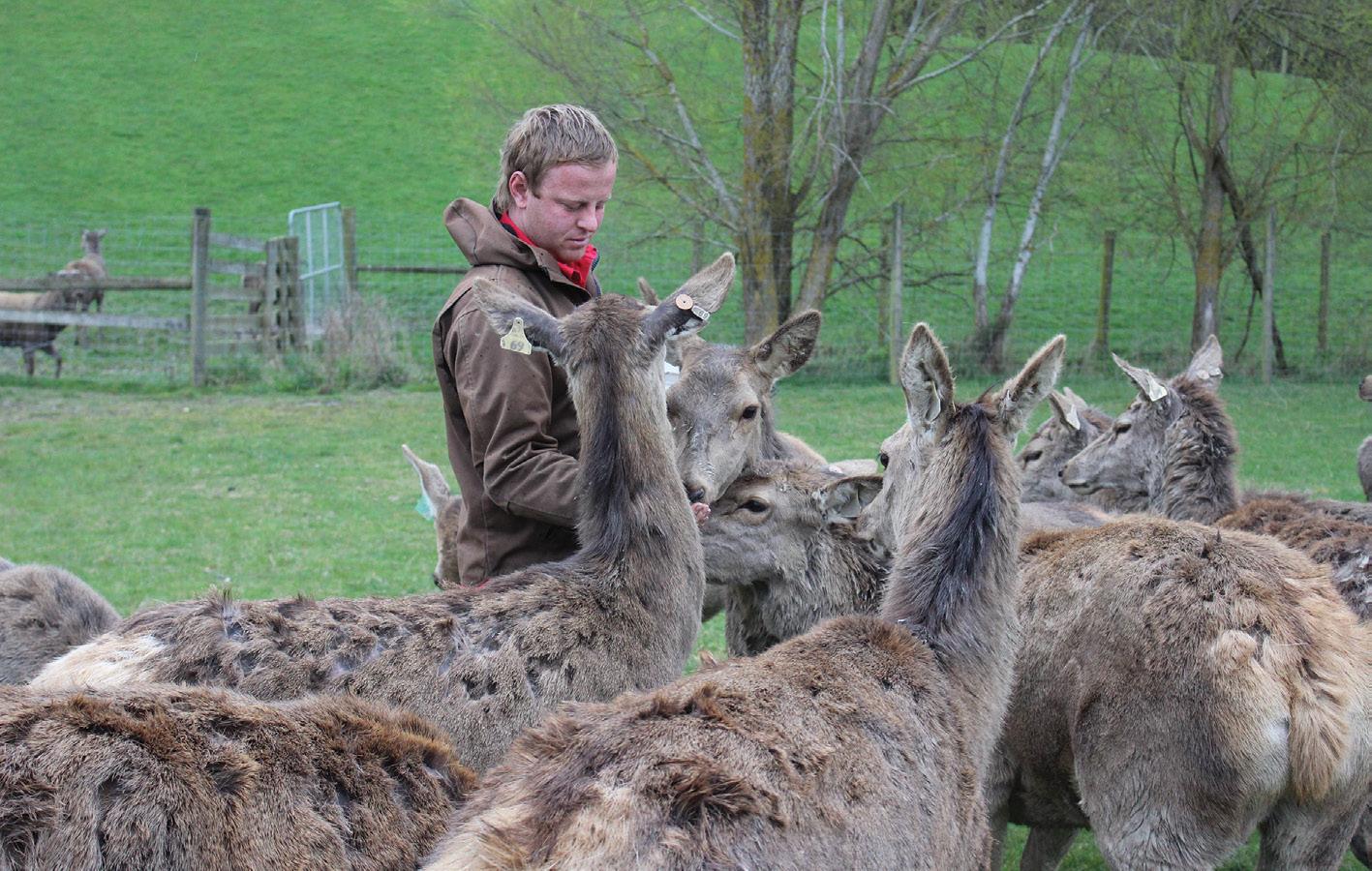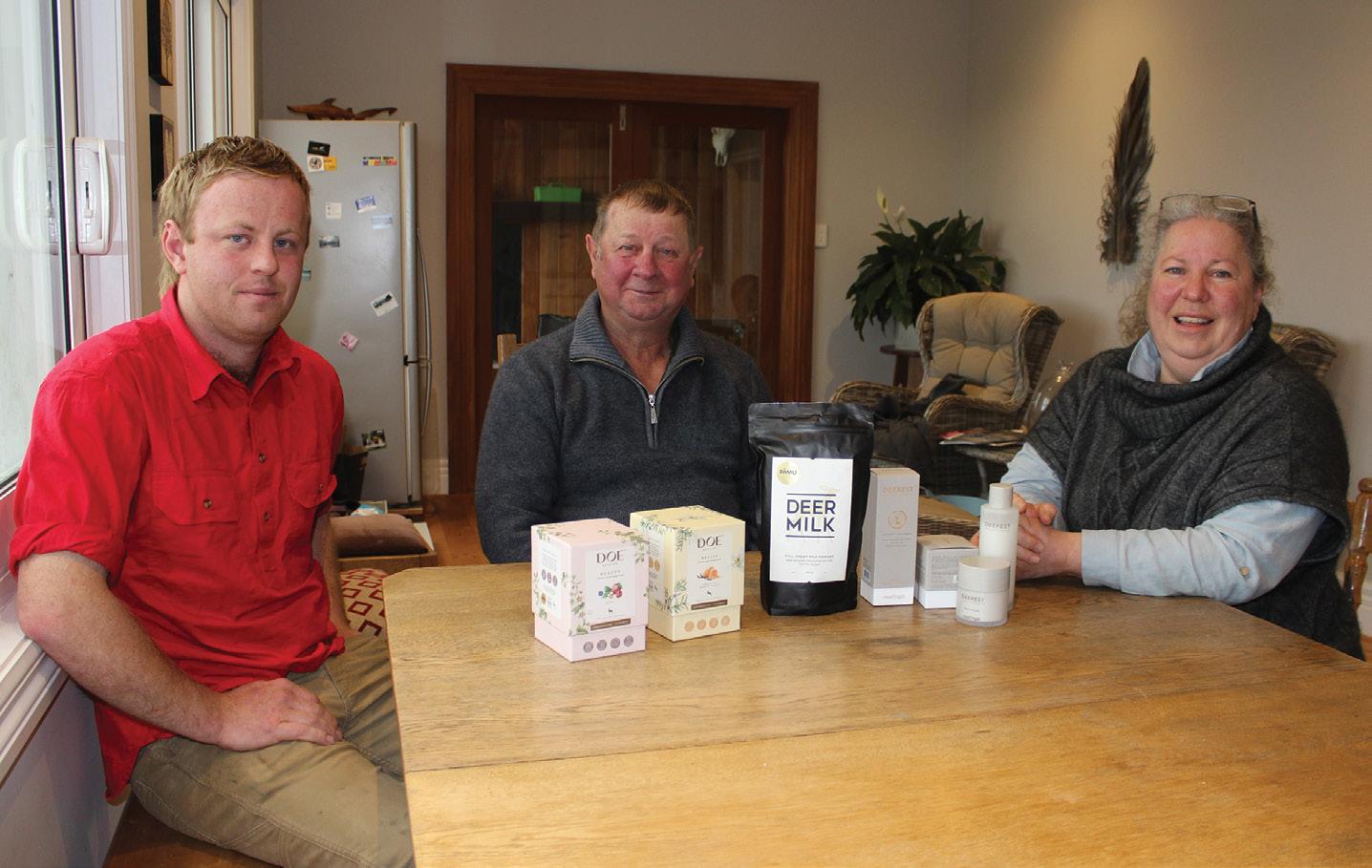
8 minute read
Deer: Hinds in control
SPECIAL REPORT MILKING IT
Hinds in control
Deer milk from a farm in Southland is part of an international awardwinning tie-up with Pāmu. Story and Photos by Karen Trebilcock.
While dairy farmers are in full swing with calving and milking, Peter McIntyre, his wife Sharon and son Chris are still taking it easy with the planned start of fawning not until November 10.
Although it’s not really them doing the planning because the milking herd of 120 deer on the eastern Southland farm are always very much in control.
“Mating is triggered by daylight hours and if it’s too cold or there is not enough feed, not that it happens on our farm, the hind can hold its baby for up to a month before giving birth,” Sharon said.
Fawning of the mixed aged hinds is usually over in two and a half weeks and last year they had 90 fawns after the first nine days to hand rear.
This year daughter Rhiannon is due home from her dive job on the Great Barrier Reef to help feed the fawns.
“They’re different to sheep or cows. With them, the young initiate feeding but for the first two weeks it’s the hinds, so you really have to make the fawns feed,” Peter said.
“At the start they won’t come running when you pour the milk into the calfeteria.”
Milking is twice-a-day until about New Year and then it’s once-a-day until drying off sometime between late February and April. Production is usually between 8000 and 12,000 litres a season depending on how long they milk for.
The milk is frozen onfarm in 10 or 20 litre bladders and trucked to Palmerston North where Pāmu take over, spray drying and packaging it into milk powder ready for reconstitution, pharmaceuticals or beauty products with South Korea the main market.
Pāmu has its own deer milking farm at Aratiatia in the North Island’s central plateau and milk from the two farms won the best dairy ingredient category for its Doe Nutrition food supplement and was highly commended in the best functional dairy category at the World Dairy Innovation Awards in Laval, France, in June. The McIntyres are happy to leave the processing and marketing of the product to Pāmu as they have enough to think about onfarm.
They were introduced to deer milking in 2014 by John and Mary Falconer who were then milking elk (Wapiti) in the Maniototo backed by Queenstown entrepreneur Graeme Shaw.

Chris McIntyre hand-feeds some of the family’s milking hinds.
Some of their plant came from them and the rest they’ve figured out through trial and, they say, a lot of error.
“The kids were keen so we decided to try it but we spent hours and hours talking, trying to solve problems when we started,” Sharon said.
A tunnel house built for the fawns proved too hot and skylights were built into the dairy and the ceilings raised as it worked better than the traditional dark rooms used for handling deer.
The high solids content of the milk made cleaning the plant problematic until Thomas Hazlett from Ecolab designed a cleaning routine for them.
The milking season coincides nicely with university holidays and it’s usually Lincoln or Massey agriculture students and trainee vets doing the work.
“The vet students really like it because there are not a lot of vets who are used to handling deer,” Sharon said.
Peak milk is about two to three litres a day with 20% solids, half and half fat and protein at the start of the season with 28% solids later. Going on once-a-day and drying off is also dictated by the deer.
“We have milked through rutting with a really quiet stag that just stayed in the paddock but it’s unusual,” Chris said.
“When the days get hot they sit around and they don’t eat so there’s no point milking them in the afternoon.
“You can’t make them eat.”
With their udders small and away from the ground, they don’t get mastitis but somatic cells can be a problem usually due to lameness, with any deer treated with antibiotics dried off.
Milking, in rows of 10, takes two and half hours to three, including washing up, and although it could be more automated Peter said the milkers enjoy the handson experience and they try to make it a positive experience for the hinds.
Cups on is about 6.30am but the deer sometimes must be woken up first and then it can take half an hour to get them from the paddock to the dairy with some wanting to follow and others taking their time and lots wanting pats along the way.
Once in the dairy, one person will be putting them in the stalls while the other starts cupping.
The amount of milk each hind gives is recorded against her tag number with all the milk traceable.
And although a deer has four teats just like a cow, they only use one cup.
“It just works best we’ve found,” Peter said.
Fawns are taken off early and the first eight milkings are colostrum and then it’s into the vat.
The fawns are hand-reared first using a bottle, with feeds four times a day, transitioning to calfeterias. When the colostrum runs out it’s lamb milk powder.
No fawns are euthanised with the males kept for velvet.
“We wouldn’t do it if we had to euthanise anything. This is not just about making money. It’s about the animals too,” Peter said.
But the hand-reared fawns can become too friendly on the farm.
“When you’re thistle-spraying or doing
a job they’ll find you and follow you right through the paddock,” Peter said.
The fifth generation on what was a traditional sheep and beef farm, Peter once worked in forestry and used to hunt.
“I was always interested in deer and then we got approached in the mid-70s to start farming them. You needed a licence back then to do it.
“We used to buy one or two animals at a time. Some of them we paid more than $5000 for.”
Although never involved in live capture, they did buy a Wapiti stag from Fiordland but now their bloodlines are pure English reds with the liveweight of mature hinds between 120kg and 150kg.
On their 320-hectare farm at Benio, they run 500 reds, mostly stags for velveting, including the 120 milking hinds.
There are also 1000 fallow deer grown for meat but also sent to hunting blocks for mostly American trophy hunters. While Covid has put a halt to that part of the business, velvet has been booming due to its health benefits.
Velvet makes up about 70% of the McIntyres’ business with meat 20% and the deer milk 10%.
They have used AI in the past but now do only natural matings, buying in stags for their velvet potential.
Deer live long enough to go through menopause at about 15 years and most of their hinds in the milking herd are 12 years or younger.
The replacement rate is about a third with the best milkers kept each year.
“They’re very smart, a lot smarter than people think,” Peter said.
“On some of the gates we have to put two latches and always have them tight otherwise they figure out pretty quickly how to open them.”
The odd wandering wild animal causes problems but are quickly dealt with before they cause trouble.
The hinds are fed “a handful” of deer nuts while milking but otherwise it’s just pasture in the summer and fodder beet or kale in the winter but they don’t get a new paddock after each milking.
“They won’t graze, they browse. They’ll eat all the chicory in a paddock and then all the plantain and then the grass. It makes it really hard to manage.
“And when you’re topping, if they’re in the paddock, you have to be careful because they won’t move out of the way if they’re lying down.”
Wallow holes are filled in as quickly as they appear and all the waterways on the farm leave via wetlands – fenced off from the deer in case they want to wallow in them as well.
Wallowing not only causes environmental problems but also results in ear tags needing to be constantly washed in the dairy.
“We’ve spent a huge amount on shade and shelter on the farm for the deer,” Peter said.
“We do it because we love the animals. They all have their own personalities.”

Chris (left), Peter and Sharon McIntyre at home with some of the high-end products their deer milk is made into.
0096705 191.75x65
Wrangler 1/4 Pg




* Good quality kiwi made & designed with 5yr structural warranty * Family owned firm for 25yrs, built on honesty & integrity * Fully equiped with all the great gear for hoof & cow care * Call now and we’ll get you sorted Race Wrangler













